Xanthoria parietina
Xanthoria parietina is a foliose, or leafy, lichen. It has wide distribution, and many common names such as common orange lichen, yellow scale, maritime sunburst lichen and shore lichen. It can be found near the shore on rocks or walls (hence the epithet parietina meaning "on walls"), and also on inland rocks, walls, or tree bark. It was chosen as a model organism for genomic sequencing (planned in 2006) by the US Department of Energy Joint Genome Institute (JGI).
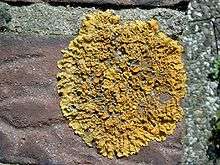
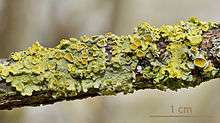
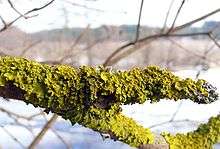
| Xanthoria parietina | |
|---|---|
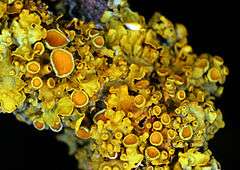 | |
| Scientific classification | |
| Kingdom: | |
| Division: | |
| Class: | |
| Order: | |
| Family: | |
| Genus: | |
| Species: | X. parietina |
| Binomial name | |
| Xanthoria parietina | |
Taxonomy
The species was first described by Carl Linnaeus in 1753, as Lichen parietinus.
Description
The vegetative body of the lichen, the thallus, is foliose, and typically less than 8 centimetres (3.1 in) wide. The lobes of the thallus are 1–4 mm in diameter, and flattened down. The upper surface is some shade of yellow, orange, or greenish yellow, while the lower surface is white, with a cortex, and with sparse pale rhizines or hapters. The vegetative reproductive structures soredia and isidia are absent in this species, however, apothecia are usually present.[1]
The outer "skin" of the lichen, the cortex, is composed of closely packed fungal hyphae and serves to protect the thallus from water loss due to evaporation as well as harmful effects of high levels of irradiation. In Xanthoria parietina, the thickness of the thalli is known to vary depending on the habitat in which it grows. Thalli are much thinner in shady locations than in those exposed to full sunshine; this has the effect of protecting the algae that cannot tolerate high light intensities. The lichen pigment parietin gives this species a deep yellow or orange-red color.[2]
X. parietina prefers growing on bark and wood; it is found more rarely on rock.[1] Nutrient enrichment by bird droppings enhances the ability of X. parietina to grow on rock.[3]
Photobiont
The photosynthetic symbionts, or photobionts, associated with X. parietina are from the green algal genus Trebouxia. Species that have been found include Trebouxia arboricola and T. irregularis.[4] Both of these photobionts are known to occur free-living in nature, having been found on bark colonized by X. parietina as well as on bark not colonized by lichens.[5]
In one study, the photobiont was shown to occupy 7% of the volume of the thallus.[6] The density of pigmentation of the upper cortex also varies and seems to control the amount of light reaching the algae.[6]
Reproduction and dispersal
A large number of lichens disperse very effectively by means of symbiotic vegetative propagules such as soredia, isidia and blastidia, and thallus fragmentation. However, X. parietina does not produce such vegetative propagules, but must establish the symbiotic state at each reproductive cycle. Two oribatid mite species, Trhypochtonius tectorum and Trichoribates trimaculatus, which are common inhabitants and consumers of X. parietina, are vectors of the photobiont cells. Faecal pellets of both species contain both viable ascospores and photobiont cells, and are suggested to be a common mode of short- and long-distance dispersal of this species.[7]
Habitat and distribution
X. parietina occurs in hardwood forests in broad, low-elevation valleys, as well as scattered on Populus and other hardwoods in riparian areas in agricultural and populated areas.[1] It is often associated with high level of nitrogen and favored by eutrophication,[8][9] and can be often found near farmland and around livestock.[10] The lichen is used as a food source and shelter for the snail Balea perversa.[11]
The species is widespread, and has been reported from Australia, Africa, Asia, North America[12] and throughout much of Europe.[13] In eastern North America and Europe, it is found more frequently near coastal locations.[1] The increases in nitrate deposition as a result of industrial and agricultural developments in southern Ontario, Canada in the 20th century are thought to be responsible for the reappearance of this species in the local lichen flora.[14]
Pollution tolerance
Xanthoria parietina is a very pollution-tolerant species. In laboratory experiments, this species can tolerate exposure to air contaminants and bisulphite ions with little or no damaging effect.[15] It is also tolerant of heavy metal contamination.[16]
For these reasons, this species has found use as a biomonitor for measuring levels of toxic elements.[17][18]
Bioactive compounds
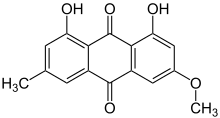
X. parietina produces an orange colored anthraquinone pigment, parietin, that is deposited as tiny crystals in the top layer of the upper cortex. Parietin synthesis is enhanced by UV-B,[19] and stimulated by photosynthates, such as those provided by the green algal Trebouxia symbiont.[20] X. parietina also produces the metabolite 2-methoxy-4,5,7-trihydroxy-anthraquinone.[21]
Medicinal properties
The water extract of X. parietina has good antiviral activity in vitro, inhibiting the replication of human parainfluenza virus type 2.[22] In the past it was used as a remedy for jaundice because of its yellow color.[23]
Gallery
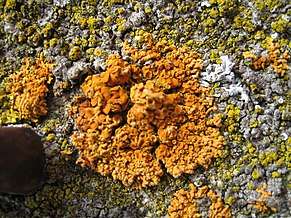 Xanthoria parietina
Xanthoria parietina.jpg) Xanthoria parietina
Xanthoria parietina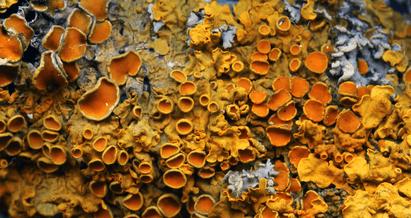 X. parietina, close-up
X. parietina, close-up
References
- Geiser, Linda; McCune, Bruce (1997). Macrolichens of the Pacific Northwest. Corvallis: Oregon State University Press. p. 321. ISBN 978-0-87071-394-1.
- Galun, Margalith (1988). CRC Handbook of Lichenology, Volume I. Boca Raton: CRC. p. 105. ISBN 978-0-8493-3581-5.
- Armstrong, R.A. (February 1984). "The influence of bird droppings and uric acid on the radial growth of five species of saxicolous lichens". Environmental and Experimental Botany. 24 (1): 95–99. doi:10.1016/0098-8472(84)90065-0.
- Ahmadjian, Vernon. (1993). The lichen symbiosis. New York: John Wiley. pp. 32–33. ISBN 978-0-471-57885-7.
- Bubrick, P.; Galun, Margalith; Frensdorff, A. (1984). "Observations on Free-Living Trebouxia De Puymaly and Pseudotrebouxia Archibald, and Evidence that Both Symbionts from Xanthoria parientina (L.) Can be Found Free-Living in Nature". The New Phytologist. 97 (3): 455–462. doi:10.1111/j.1469-8137.1984.tb03611.x. JSTOR 2432333.
- Biology of Lichens. Cambridge, UK: Cambridge University Press. 1983. p. 51. ISBN 978-0-7131-2457-6.
- Meier, Franz A.; Scherrer, Sandra; Honegger, Rosmarie (28 June 2008). "Faecal pellets of lichenivorous mites contain viable cells of the lichen-forming ascomycete Xanthoria parietina and its green algal photobiont, Trebouxia arboricola". Biological Journal of the Linnean Society. 76 (2): 259–68. doi:10.1111/j.1095-8312.2002.tb02087.x.
- Gaio-Oliveira, Gisela; Dahlman, Lena; Palmqvist, Kristin; Mguas, Cristina (January 2004). "Ammonium uptake in the nitrophytic lichen Xanthoria parietina and its effects on vitality and balance between symbionts". The Lichenologist. 36 (1): 75–86. doi:10.1017/S0024282904014124.
- van Herk, C. M. (28 March 2007). "Mapping of Ammonia Pollution with Epiphytic Lichens in the Netherlands". The Lichenologist. 31 (1): 9–20. doi:10.1006/lich.1998.0138.
- Frati, L.; Santoni, S.; Nicolardi, V.; Gaggi, C.; Brunialti, G.; Guttova, A.; Gaudino, S.; Pati, A.; Pirintsos, S.A.; Loppi, S. (March 2007). "Lichen biomonitoring of ammonia emission and nitrogen deposition around a pig stockfarm". Environmental Pollution. 146 (2): 311–316. doi:10.1016/j.envpol.2006.03.029. PMID 16777293.
- Baur, Bruno; Baur, Anette (2007). "Xanthoria parietina as a food resource and shelter by the land snail Balea perversa". The Lichenologist. 29 (1): 99–102. doi:10.1017/S0024282997000145.
- Hogan, C. Michael. 2008. Black Spruce: Picea mariana, GlobalTwitcher.com, ed. Nicklas Stromberg Archived October 5, 2011, at the Wayback Machine
- Lindblom, Louise (1997). The genus Xanthoria (Fr.) Th.Fr. in North America (Thesis). Lund University. ISBN 978-91-628-2777-9.
- Brodo, Irwin M.; Lewis, Chris; Craig, Brian (June 2007). "Xanthoria parietina, a Coastal Lichen, Rediscovered in Ontario". Northeastern Naturalist. 14 (2): 300–306. doi:10.1656/1092-6194(2007)14[300:XPACLR]2.0.CO;2.
- Silberstein, L.; Siegel, B. Z.; Siegel, S. M.; Mukhtar, A.; Galun, M. (28 March 2007). "Comparative Studies on Xanthoria Parietina, a Pollution Resistant Lichen, and Ramalina Duriaei, a Sensitive Species. I. Effects of Air Pollution on Physiological Processes". The Lichenologist. 28 (4): 355–365. doi:10.1006/lich.1996.0033.
- Backor, M.; Fahselt, D.; Davidson, R. D.; Wu, C.T. (1 August 2003). "Effects of Copper on Wild and Tolerant Strains of the Lichen Photobiont Trebouxia erici (Chlorophyta) and Possible Tolerance Mechanisms". Archives of Environmental Contamination and Toxicology. 45 (2): 159–167. doi:10.1007/s00244-002-0134-6.
- Brunialti, G.; Frati, L. (15 November 2007). "Biomonitoring of nine elements by the lichen Xanthoria parietina in Adriatic Italy: A retrospective study over a 7-year time span". Science of the Total Environment. 387 (1–3): 289–300. doi:10.1016/j.scitotenv.2007.06.033. PMID 17716704.
- Loppi, Stefano; Paoli, Luca; Gaggi, Carlo (17 March 2006). "Diversity of Epiphytic Lichens and Hg Contents of Xanthoria parietina Thalli as Monitors of Geothermal Air Pollution in the Mt. Amiata Area (Central Italy)". Journal of Atmospheric Chemistry. 53 (2): 93–105. doi:10.1007/s10874-006-6648-y.
- Solhaug, Knut Asbjorn; Gauslaa, Yngvar; Nybakken, Line; Bilger, Wolfgang (April 2003). "UV-induction of sun-screening pigments in lichens". New Phytologist. 158 (1): 91–100. doi:10.1046/j.1469-8137.2003.00708.x.
- Solhaug, K. A.; Gauslaa, Y. (February 2004). "Photosynthates stimulate the UV-B induced fungal anthraquinone synthesis in the foliose lichen Xanthoria parietina". Plant, Cell and Environment. 27 (2): 167–176. doi:10.1111/j.1365-3040.2003.01129.x.
- Ivanova V, Schlegel R, Gräfe U (October 2000). "2-Methoxy-4,5,7-trihydroxy-anthraquinone, a new lichen metabolite produced by Xanthoria parietina". Pharmazie. 55 (10): 785–6. PMID 11082848.
- Karagoz, Ali; Doğruöz Güngör, Nihal; Zeybek, Zuhal; Aslan, Ali (December 2014). "Antibacterial activity of some lichen extracts". Journal of Medicinal Plant Research. 60 (3): 281–6.
- Vartia, K.O. (1973). "Antibiotics in Lichens". The Lichens. pp. 547–561. doi:10.1016/b978-0-12-044950-7.50022-2. ISBN 978-0-12-044950-7.
External links
| Wikimedia Commons has media related to Xanthoria parietina. |
- Radoslaw Walkowiak, Akira Takeuchi, Short Note of Xanthoria parietina, CTC PAPER 2020
- http://www.jgi.doe.gov/sequencing/why/CSP2006/Xparietina.html
- http://www.nhm.ac.uk/nature-online/species-of-the-day/biodiversity/climate-change/xanthoria-parietina/index.html